
Iris is a flowering plant genus of 310 accepted species with showy flowers. As well as being the scientific name, iris is also widely used as a common name for all Iris species, as well as some belonging to other closely related genera. A common name for some species is flags, while the plants of the subgenus Scorpiris are widely known as junos, particularly in horticulture. It is a popular garden flower.

Iris bucharica is a species of flowering plant in the family Iridaceae. It is a bulbous herbaceous perennial, from temperate Asia, within Afghanistan, Tajikistan and Uzbekistan. It has long blue green leaves, many flowers in spring, in shades of yellow and white.
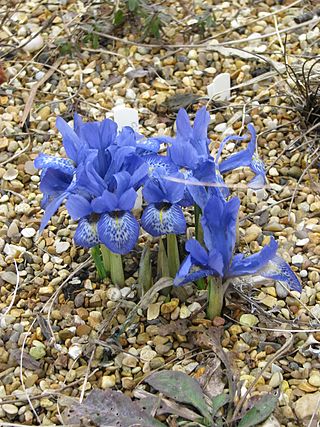
Iris histrioides, the orchis iris, winter iris or Harput iris, is a species of flowering plant in the genus Iris, subgenus Hermodactyloides of the family Iridaceae. It is a bulbous perennial, that is native to Turkey, and has bluish scented flowers. It is cultivated as a plant for ornamental purposes in temperate regions, and has many known cultivars.

Iris reticulata var. bakeriana is a variety of Iris reticulata, a plant in the genus Iris. It is sometimes treated as Iris bakeriana, especially in the USA.
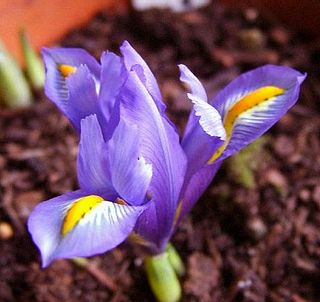
Iris hyrcana, the Hyrcana iris, is a plant species in the genus Iris, it is classified in the subgenus Hermodactyloides and section Reticulatae. It is a bulbous perennial from central Asia, from Azerbaijan to Iran.
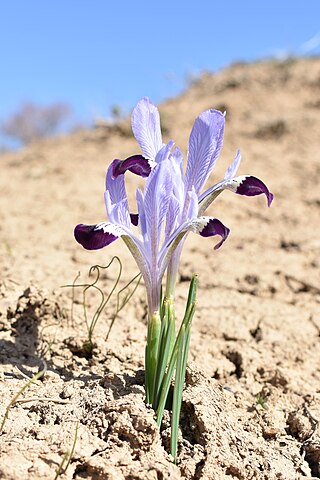
Iris kolpakowskiana, or Kolpakowski's iris, is a plant species in the genus Iris, it is classified in the subgenus Hermodactyloides and section Monolepsis. It is a bulbous perennial from Asia.
Iris pamphylica is a plant species in the genus Iris. It is the largest member of the subgenus Hermodactyloides, it is also in the section Reticulatae. It is a bulbous perennial from Antalya Province in Turkey, Asia. It has long narrow leaves, shorter stem holding a bi-coloured flower in shades of purple, blue or purple-brown, with a yellow, purple-spotted section on a petal.

Iris winogradowii is a species of flowering plant in the genus Iris, classified in the subgenus Hermodactyloides and section Reticulatae. It is a bulbous perennial, from the Caucasus mountains of Azerbaijan and Georgia.

Iris histrio, the Syrian iris, is a species in the genus Iris, it is classified in the subgenus Hermodactyloides and section Reticulatae. It is a bulbous perennial from Central Asia: Kyrgyzstan, Israel, Lebanon, Syria and southern Turkey.
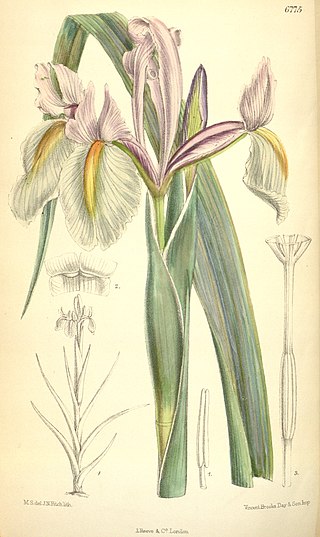
Iris tingitana is a species in the genus Iris in the subgenus of Xiphium.
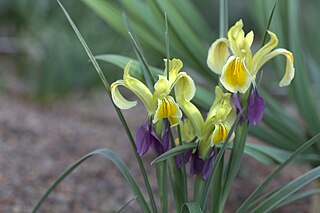
Iris fosteriana is a species in the genus Iris, subgenus Scorpiris.
Iris vicaria is a species in the genus Iris, it is also in the subgenus Scorpiris. It is a bulbous perennial from Asia, found in Tajikistan, Turkmenistan and Uzbekistan. It has tall arching leaves, and has varied coloured flowers, with white, blue and purple between April and May.

Iris attica, the Greek iris, is a plant species in the genus Iris, it is also in the subgenus Iris. It is a rhizomatous perennial, from the mountains of the Balkans in Europe, within the countries of Greece, former Yugoslavia, Turkey and North Macedonia. It has sage green or grey-green leaves, that are sickle-shaped, a stout short stem and 2 variable flowers, in shades from yellow to purple. They have a white or blue beard. It is often called Iris pumila subsp attica, but is classified in most sources, as a separate species, although it is closely related to Iris pumila, as a possible parent plant. It is cultivated as an ornamental plant in temperate regions.
Iris griffithii is a plant species in the genus Iris, it is also in the subgenus Iris. It is a rhizomatous perennial, from Afghanistan. It has short, sickle-shaped leaves, short green stem and purple flowers with white beards. Several specimens exist within herbaria around Europe, but it is rarely cultivated.
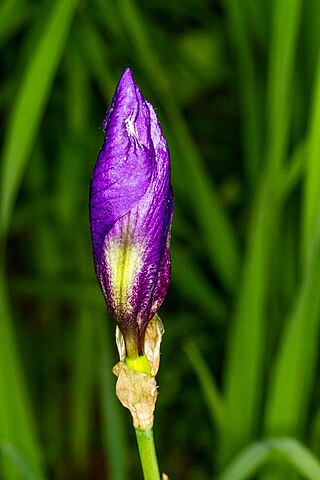
Iris sambucina, the elder scented iris, is a plant species in the genus Iris, it is also in the subgenus Iris. It is a rhizomatous perennial, from southern and central Europe. It has green, curved or sword-like leaves, tall round stem, multiple flowers in shades from brown violet, or brown-purple, to purple-violet, blue violet, mauve, and to purple. The large flowers are fragrant, with the scent of elderflowers, hence the name. It was first considered a separate species, then it was classified as a synonym of Iris germanica, before being classified as a separate species again, but with a hybrid origin from Iris pallida and Iris variegata. It is sometimes cultivated as an ornamental plant in temperate regions.

Iris suaveolens is a plant species in the genus Iris, it is also in the subgenus Iris. It is a rhizomatous perennial, from Eastern Europe, ranging from the Balkans to Turkey. It has short, sickle shaped or curved, blue-green or greyish green leaves, a slender simple stem, with 1 or 2 fragrant spring blooming, flowers, between yellow and purple, with white or yellow beards. It was once known as Iris mellita, until that was re-classified as a synonym of Iris suaveolens. It is cultivated as an ornamental plant in temperate regions.
Iris heylandiana is a species in the genus Iris, it is also in the subgenus Iris, and in the section Oncocyclus. It is a rhizomatous perennial, from the marshlands or fields of Iraq. It has short, linear or sickle shaped grey-green leaves, slender stem, a single flower in spring, which has a dingy-white, whitish, or pale background, which is covered in many spots or dark veining, in black-purple, brown-purple, or brown violet, or brown shades. It has a dark brown or burgundy brown signal patch and white tinged with yellow or orange white sparse beard. It is rarely cultivated as an ornamental plant in temperate regions, as it needs very dry conditions during the summer.
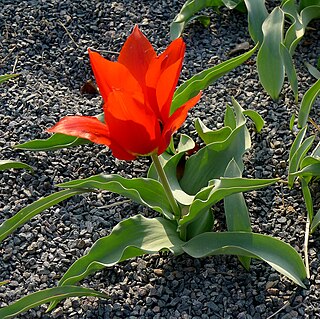
Tulipa eichleri, commonly known as Eichler tulip or Eichler's tulip, is a species of tulip. It is a bulbous flowering perennial with long green leaves,deep red flowers with a central black blotch, coming from the Caucasus Mountains.

Iris sari is a species in the genus Iris, it is also in the subgenus Iris and in section Oncocyclus. It is from the rocky steppes and hills of Turkey. It has curved or straight leaves, cream, greenish or yellowish flowers which are variable and veined with crimson, purple-brown, reddish brown, reddish-purple or black. It has a dark maroon, rich crimson or brown signal patch and gold or yellow beard.
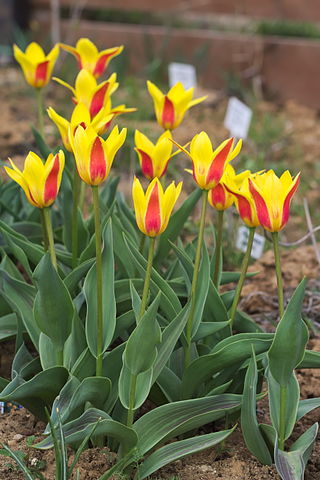
Tulipa kaufmanniana, the water lily tulip, is a species of tulip native to Central Asia.


















